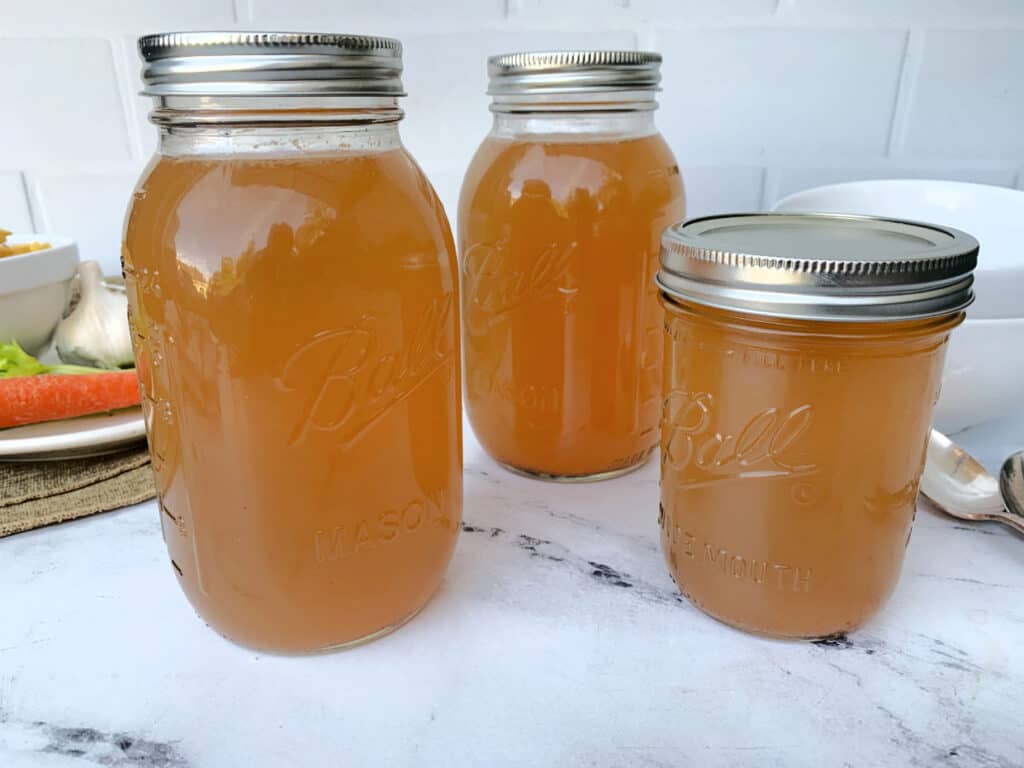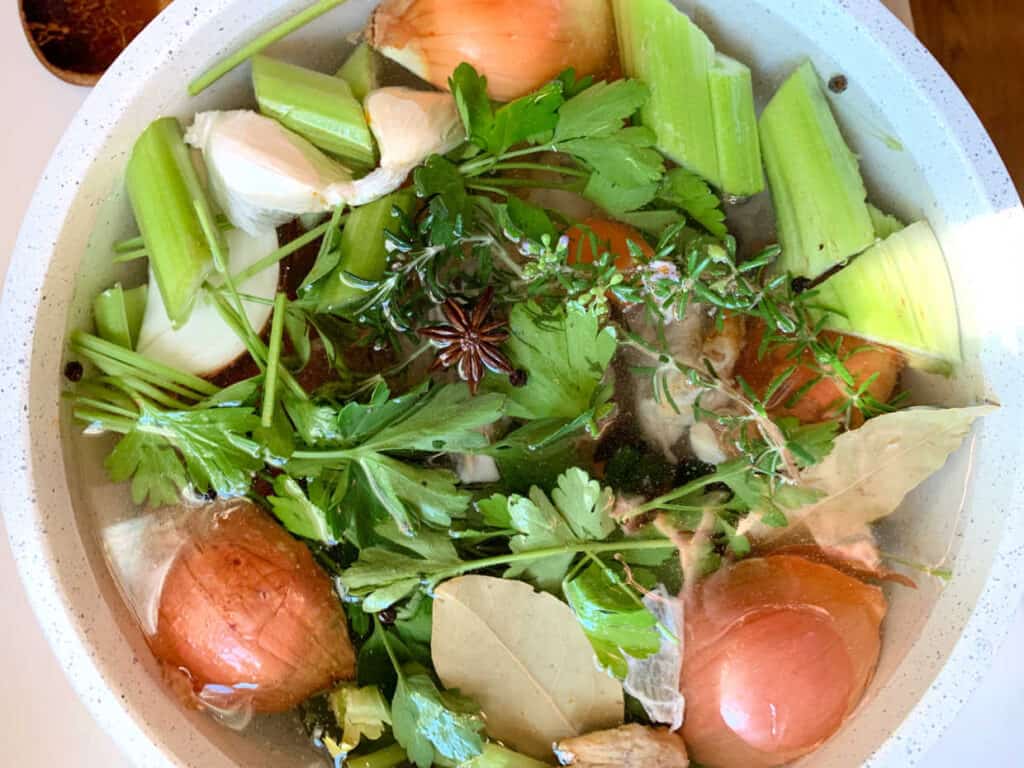Have you ever wondered what to do with that leftover chicken carcass or those sad-looking vegetables in the crisper? You can turn those ingredients into homemade chicken stock. There is no need for fancy kitchen gadgets; you only need a pot, some basic ingredients and a bit of time.

A pot of simmering chicken stock will fill your kitchen with a delicious aroma that’s good for just about anything. Whether you want to make a sauce quickly, enhance the flavor of your rice or use it as the base for a nourishing soup, the possibilities are endless. It’s the kitchen multitasker you didn’t know you needed — versatile, fuss-free and bound to make you feel like a culinary pro.
The chicken stock vs. chicken broth debate
Chicken stock and chicken broth are frequently used interchangeably in everyday cooking. In many recipes, either can be used depending on personal preference and ingredient availability.
Chicken stock is made by simmering chicken bones, along with vegetables and aromatics over an extended period. This longer cooking time allows for the extraction of deep flavors and collagen from the bones, resulting in a richer and more intense flavor. Typically, chicken stock serves as a robust foundation for sauces and heartier dishes, lending them a full-bodied flavor.
On the other hand, chicken broth is made by simmering chicken meat alongside vegetables and seasonings, but for a shorter duration compared to stock. This results in a lighter flavor profile that emphasizes the taste of the chicken meat itself. Chicken broth is commonly utilized as a standalone soup or in recipes where a lighter touch is desired, bringing a more subtle chicken flavor to the forefront.
“I always save scraps from chopping vegetables to use for making chicken broth. It’s so easy to save the ends of carrots, celery, onions and more in the freezer! It saves me a lot of time during the day, adds flavor and reduces food waste. An all-around win!”
— Megan Myers, Stetted
The benefits of homemade chicken stock
Using homemade chicken stock in your dishes gives them a special flavor boost. It makes everything taste richer and more authentic.
Rich in nutrients: Homemade chicken stock is packed with essential nutrients derived from the simmered bones and vegetables, offering a wholesome and nourishing addition to your diet.
Provides a natural source of collagen: The slow cooking process extracts collagen from the bones, contributing to the broth’s natural richness.
You can control the flavor: Making your stock allows you to adjust the seasoning to match your taste buds, guaranteeing it’s just right — not too salty or bland.
Better flavor: Compared to store-bought versions, homemade chicken stock delivers a depth of flavor that’s hard to match, elevating the taste of your soups, stews and other dishes to a whole new level.
Basic ingredients and equipment needed
The first step to making delicious homemade chicken stock is gathering the right ingredients and tools. Ensure you have fresh chicken bones, aromatic vegetables, a large stockpot and a fine-mesh strainer for optimal results.

- Chicken parts: You can use the meat, skin and bones from a chicken carcass, bones from chicken pieces or a combination. Using chicken wings is a good option as well.
- Vegetables: These are an essential component for flavor. Onions, carrots and celery are staples in stock, but you can also use a variety of other vegetables.
- Aromatics: Garlic, herbs and spices are needed for flavoring. Try using whole peppercorns and anise seeds for great flavor.
- Water: Use plenty of water to submerge the stock ingredients.
- Stockpot or slow cooker: Use a large enough pot to hold the water and ingredients.
- Strainer: This is necessary for straining out the solid ingredients.
“Simplicity is key when making homemade chicken broth. I like to place chicken bones or a leftover carcass into my crockpot and add onions, carrots, celery and a handful of fragrant herbs such as thyme and parsley. Then, I let the slow cooker do its work. The broth is a staple in my home for making soup, rice and gravy.”
— Jessica Haggard, Primal Edge Health
7 easy steps for homemade chicken stock
In the process of making your homemade chicken stock, follow these seven easy steps for a flavorful and versatile addition to your kitchen. Enjoy the rich aroma of the broth as it simmers in your pot.

- Add the chicken pieces, vegetables and herbs to a stockpot.
- Cover the ingredients with cold water.
- Bring the water to a boil, turn the heat to low and simmer uncovered for three to four hours. The longer you let the broth simmer on the stove, the better the flavor you will have.
- Stir the pot occasionally to distribute the ingredients and add extra water if necessary to submerge everything.
- Let the broth cool and then carefully lift the chicken bones out of the liquid. Strain the stock to capture the vegetables and any remaining bits, leaving you with a clear, golden stock.
- Taste the stock to determine if any additional seasonings are required. However, keep in mind that this stock will likely be used in other recipes that will also require seasoning.
- Allow the stock to cool completely, transfer it to storage containers and refrigerate. Or pour it into freezer bags for putting in the freezer where it will last several months.
Customize the stock
The beauty of homemade chicken stock lies in its adaptability. You can experiment with different herbs, spices and vegetable combinations, tailoring them to suit your taste and match various recipes.
Learn how to freeze your vegetable scraps. When preparing herbs and vegetables, such as carrots and onions, save the peels, ends of tomatoes and peppers and stems of herbs in a freezer bag. These scraps can be stored in the freezer and used later for making broth.
“I love to use homemade chicken broth to infuse flavor and nutrition into simple foods. I use broth as the cooking liquid for rice, most grains and potatoes.”
— Michelle Goth, Blackberry Babe
This is a must-have recipe for making homemade chicken stock, a kitchen staple you will want to have on hand in your fridge and freezer. This flavorful stock can be used in various soup recipes, and casseroles, added to pan sauces or used to enhance the flavor of numerous dishes.
Jere Cassidy is the writer and recipe developer behind the blog One Hot Oven. A passion for all things food-related led her to culinary school to expand on her baking skills and now to sharing easy recipes for all home cooks and bakers of all skill levels. When not in the kitchen, Jere’ likes to travel far and wide to find delicious food.